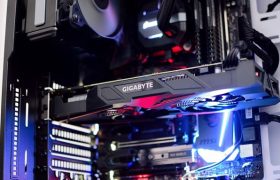The idle GPU temp refers to the temperature of a graphics card when it is not actually being used. It reveals the temperature at which the computer will shut down. An idle temp around 45 degrees proves that your computer’s gpu is functioning properly and will be able to last longer than usual. For example, if you leave your computer on for about 10 hours per day, with an idle temp of 45 degrees, you can expect a lifespan of about 1000 hours.
Idle Gpu Temperature
If you’re looking to keep an eye on your Nvidia GPU’s idle temperature, here are some tools and tips you can use.
Nvidia inspector is a great tool for monitoring your GPU’s idle temperature. It provides detailed information about the GPU’s temperature, fan speed, and power usage. You can also use this tool to diagnose issues with your graphics card.
GPU-Z is another great tool for monitoring your GPU’s idle temperature. It provides detailed information about the GPU, including the clock speed, memory size, and fan speeds. You can also use this tool to diagnose issues with your graphics card.
Difference Between Idle And Peak Gpu Temperatures
GPUs are designed to run at a much lower temperature when they’re not in use, but some gamers may still want to monitor their idle GPU temperature to ensure that it’s staying within safe limits. The two main things to keep in mind when monitoring an idle GPU temperature are the temperature range and the variance.
The temperature range is the maximum and minimum allowable temperatures for the card, while the variance is the degree of variation between those two temperatures. A variance of 10 degrees is acceptable, but if the idle GPU temperature falls outside of that range by more than 5 degrees, you should consider taking action to fix the issue.
Here are a few guidelines for monitoring an Nvidia GPU’s idle temperature:
-Start by checking your card’s specifications to see what temperature range your particular model supports.
-Set up a monitoring program with a reliable sensor and accurate readings.
-Monitor your card’s Idle Temp constantly in intervals of 5 minutes or longer, and take corrective action if needed.
What High Numbers Mean
Bloggers often talk about what “high” or “low” temperatures mean when it comes to graphics cards and it can be tough to decipher the meaning without a little more information. For the most part, temperatures above or below a certain threshold are considered abnormal and could indicate a problem with your graphics card.
GPUs have several components that work together to process graphics data and the majority of heat production comes from the GPU. When the GPU is idle, its temperature will be higher than when it is working because it’s not using all of its power to render images.
If you see your GPU temperature consistently spike up above 100°C, there may be an issue with your graphics card. This could be due to a faulty component, overheating, or something more serious like a leaky fan. If you find that your temperatures are too high all the time even when your PC isn’t running any games or other intensive applications, there may be a problem with your cooling system and you should consider replacing it.
Important Information About Low Temp and Recommended Temperatures
Nvidia GPUs are notorious for running hot, and it’s important to know how to monitor and keep them cool. When your Nvidia GPU is running too hot, it can cause your system to falter or even fail. Here are a few key tips to keep your GPU cool and manage idle temperatures:
- Monitor your GPU temperature regularly with a tool like MSI Afterburner or 3DMark Time Spy. This will help you identify any out-of-the-ordinary thermal spikes, and give you an early warning if something is going wrong.
- Keep your graphics card well-ventilated. Nvidia recommends keeping your GPU fan at a setting of “40%” or lower when gaming or working on high-intensity tasks. A poorly ventilated graphics card can cause serious heat buildup, leading to overheating and possible damage.
- Keep your computer free from excess heat sources. If you’re using a desktop computer, make sure there are no other components nearby that could create extra heat (like a radiator or powerful fan). If you’re using a laptop, try to keep the lid closed as much as possible to reduce airflow interference.
Conclusion
Monitoring the idle temperature of an Nvidia GPU can help you get the most out of your hardware and keep your system running as cool as possible. By knowing the temperature at which your Nvidia GPU is operating, you can determine when it is time to adjust settings or replace the graphics card.


